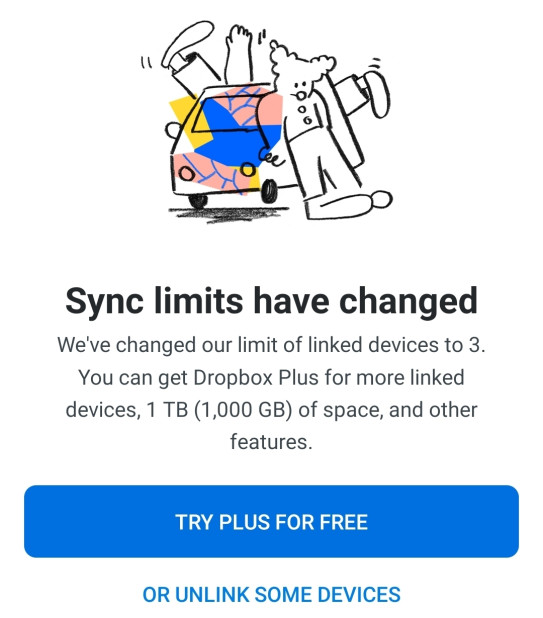Dropbox limits syncing: now only 3 devices

Dropbox service is very convenient - with it you can store quite a lot of data in the cloud, all of which are accessible from any device connected to the cloud. Rather, they were available - a few days ago, the service set a new restriction: now free account holders can now connect only 3 devices to Dropbox.
If you want more, then you have to pay - in the company's opinion, $ 8.25 is quite a decent price for extended support for devices. This is the minimum bar for a paid rate, it is clear that the more payment, the more functions available to the user.
The restriction was introduced without undue publicity, the company was not very actively writing about the limit. The positive thing is that users with free accounts that have already connected more than 3 gadgets will not be affected by the new rules - nothing is planned to be disabled. But to connect a larger number of devices will not work.
')
When the limit is reached, the user will be shown a list of connected devices, so if you want, you can turn off something by replacing the unnecessary item with a new device. But it is clear that the company encourages users to connect to new tariff plans.

The browser version of the service so far allows users from any devices - probably the restriction will not work here (that is, the system does not track the number of PCs or mobile devices from which browsers users log in).
Previously, Dropbox focused its business on corporations; it’s most profitable to work with cloud service companies - they are the most solvent customers. In an effort to improve the efficiency of their own business, the management of the service decided to pay attention to ordinary users, who mostly work with free accounts.
True, here the company is already taking risks, since some users may simply go to competitors - and there are quite a few of them, competitors. On the other hand, the loss of users who do not pay is not a big problem, rather, on the contrary, a company can free up the resources required to meet the needs of paid users. Yes, and competitors are also not sugar conditions. For example, in Evernote, a free subscription includes only two devices that can be synchronized with your account.
The most obvious reason that may encourage users to pay is the increase in file space. By default, only 2 GB is available. A tariff plan with a payment of $ 8.25 increases the volume to 1 TB. $ 16 is already 2 TB.
Dropbox's closest competitor, Box (which, however, is almost 100% targeted at corporate users), offers 10 GB of file space for users with free accounts. Google Drive has 15 GB distributed between Google Photos and Gmail. For $ 2 per month, you get about 100 GB from Google. Amazon and Microsoft offer a default of 5 GB. And no one has a limit on the number of devices connected to the account.
Dropbox is also forced to do something because now out of 500 million registered users only 2.5% pay. It is possible that someone would have moved into the category of paid users out of all this amount, but after changes in the company's policy this may not happen (or, on the contrary, more users will pay, many simply don’t want to change the convenient platform). In principle, a calculation can be built on this - those who are not tied up with Dropbox and do not pay will be able to move to another site. But users who are largely dependent on Dropbox and, with all their desire, will not be able to quickly replace the service, will pay.
In order to attract more users, Dropbox joins forces with other services. So, recently, management signed a cooperation agreement with Klaxoon, Pronto and WeVideo. The first service provides voting, Pronto is a real-time chat, WeVideo is a video editor.
The service also attracts representatives of the field of education - students, teachers and entire educational institutions can connect using the Dropbox Education program. At the moment, this category of users has already posted more than 2.5 billion files - according to Dropbox itself.
Source: https://habr.com/ru/post/444198/
All Articles